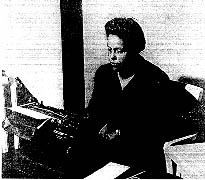Harlem Renaissance Poet and Art Activist
Born in Texas, poet and arts activist Gwendolyn Bennett moved to New York in her teens and, in the 1920’s, was instrumental in the Harlem Renaissance and the Black American arts movement. The name of the Harlem movement was fitting for a woman of her many talents: Bennett was a poet, illustrator, graphic artist, teacher, arts educator, administrator, journalist, and mentor. Joining with other Harlem writers, she helped found Fire!!, a quarterly journal celebrating the art of young African Americans, and she used a column she wrote in another publication, Opportunity, to expose her readers to new, young poets, and open a dialogue about the renaissance. In her poetry, she explored her African heritage, and echoed many important Harlem Renaissance themes: an appreciation of African music and art, a return to Africa, and racial pride. Her graphic art graced the cover of the NAACP publication Crisis five times, and she was critically renowned as an important, talented, and versatile artist.
She worked hard to ensure young poets had a place to create, founding groups with other Harlem artists, safe spaces for young African-American artists to interact with one another. When the depression came, she began to focus even more on encouraging young people to create. From 1935-1944, she was director of the Harlem Community Arts Centre, and she directed the development of the George Washington Carver Community School.
A pioneer from a young age, both personally and professionally, she was the first African American in her high school to be nominated for literary and dramatic societies. Bennett graduated from the Pratt Institute in New York, and over her career would teach art at Howard University, and study in Paris. Her second marriage, in 1940, was inter-racial, a rare thing at the time. Bennett is remarkable not only for her talent, but for her drive and dedication to giving African Americans a voice. At a time when women were often viewed as second-class citizens, Bennett was a force to be reckoned with, working ceaselessly, whether mentoring young artists, mounting gallery exhibitions, or writing, to ensure the development of African American art.



 Follow Us On Instagram
Follow Us On Instagram
